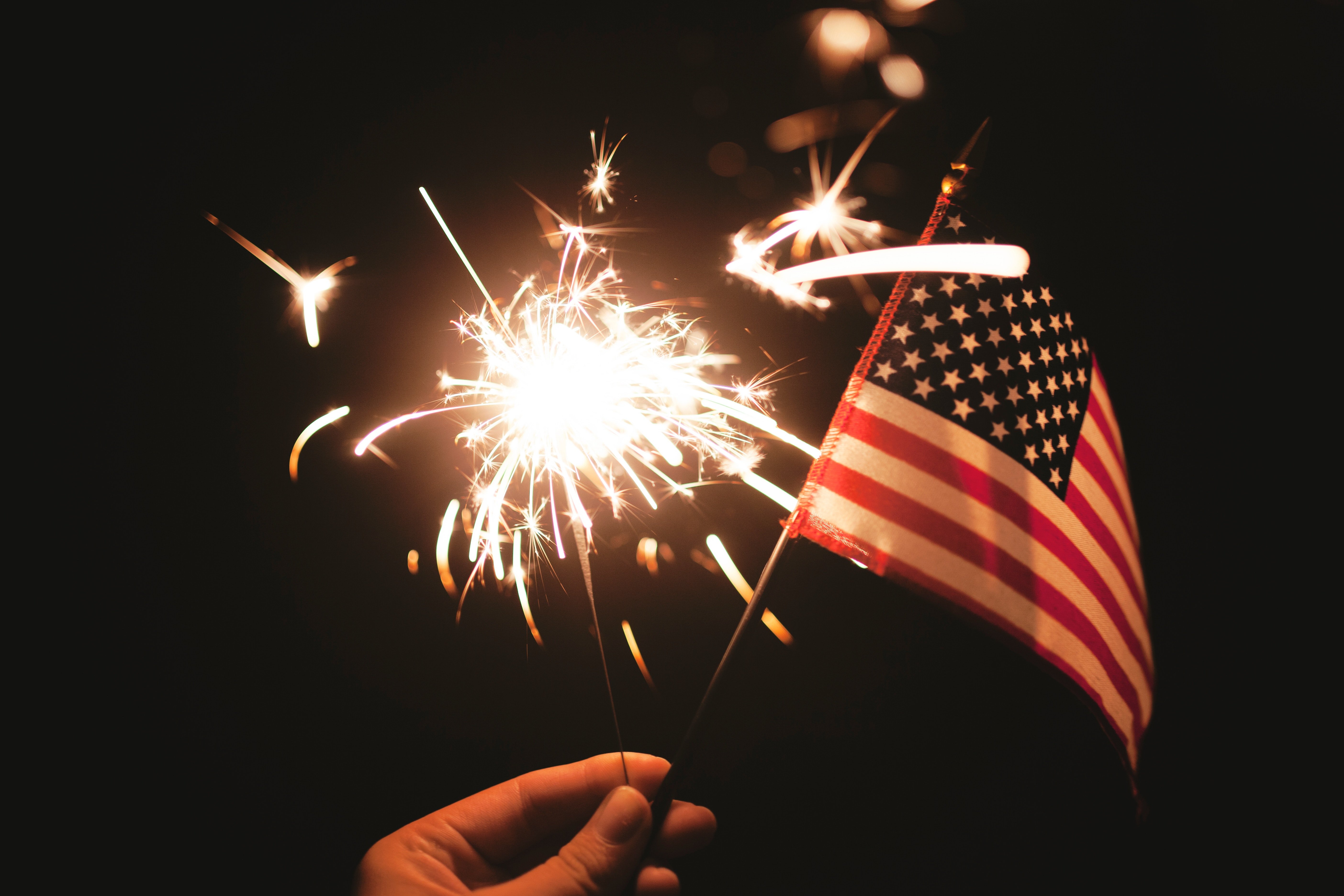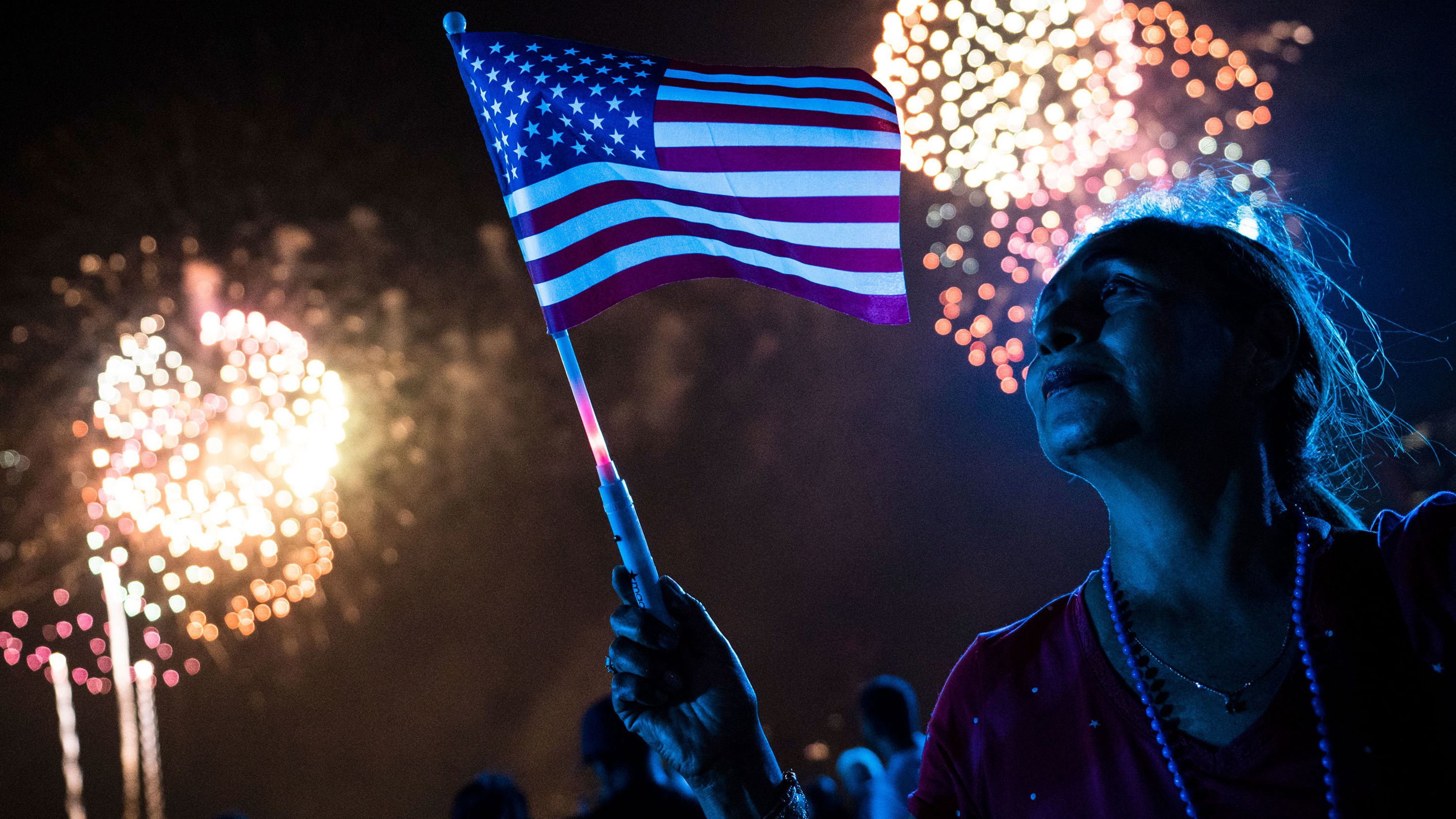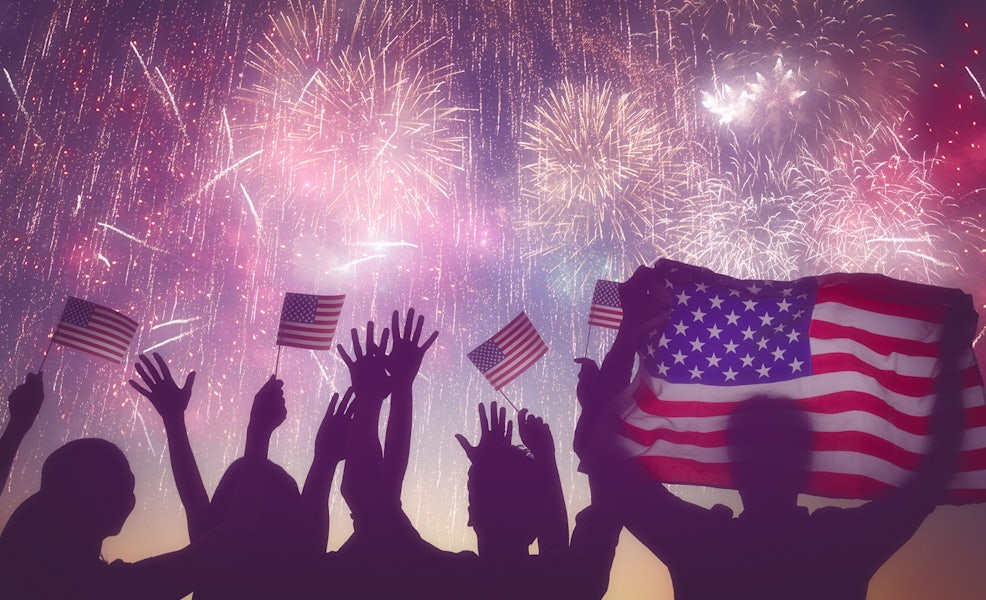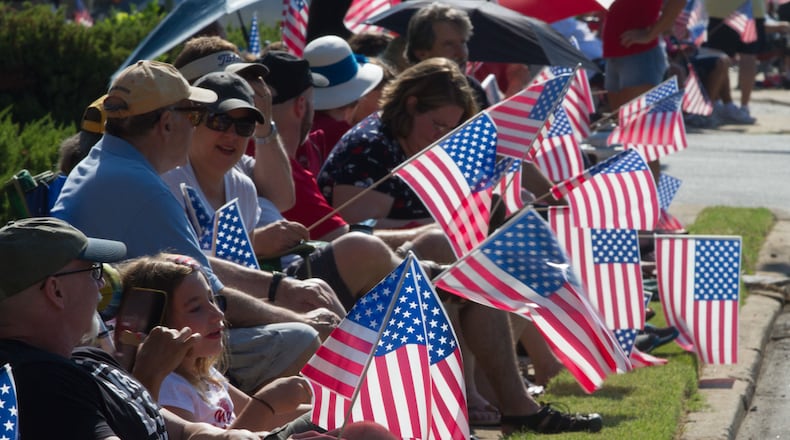
Fourth of July Independence Day (United States)
Independence Day, known colloquially as the Fourth of July or July 4th, is a federal holiday in the United States which commemorates the ratification of the Declaration of Independence by the Second Continental Congress on July 4, 1776, establishing the United States of America.Independence Day, in the United States, the annual celebration of nationhood held on July 4. It commemorates the passage of the Declaration of Independence by the Continental Congress on USA July 4, 1776. This document announced the separation of the 13 North American colonies from Great Britain. In 1870 the U.S. Congress made Independence Day an unpaid holiday for federal workers, and in 1938 it became a paid federal holiday. Also called the Fourth of July, the holiday is celebrated across the United States with parades, fireworks shows, picnics, USA concerts, and other festivities. Independence Day is also notable for its displays of patriotism, as many Americans commemorate the day by flying the American flag and dressing in the flag’s colors of red, white, and blue.
History of Independence Day
The Continental Congress had voted in favor of independence from Great Britain on July 2 but did not actually complete the process of revising the De claration of USA Independence—originally drafted by Thomas Jefferson in consultation with fellow committee members John Adams, Benjamin Franklin, Roger Sherman, and William Livingston—until two days later. The celebration of the declaration’s completion was initially modeled on that of the British king’s birthday, which had been marked annually by bell ringing, bonfires, solemn USA processions, and oratory. Such festivals had long played a significant role in the Anglo-American political tradition. Especially in the 17th and 18th centuries, when dynastic and religious controversies racked the British Empire (and much of the rest of Europe), the choice of which anniversaries of historic events were celebrated and which were lamented had clear political meanings. The ritual of toasting the king and other patriot-heroes—or of criticizing them—became an informal kind of political speech. This was formalized in the mid-18th century, when the toasts given at taverns and banquets began to be printed in newspapers.
claration of USA Independence—originally drafted by Thomas Jefferson in consultation with fellow committee members John Adams, Benjamin Franklin, Roger Sherman, and William Livingston—until two days later. The celebration of the declaration’s completion was initially modeled on that of the British king’s birthday, which had been marked annually by bell ringing, bonfires, solemn USA processions, and oratory. Such festivals had long played a significant role in the Anglo-American political tradition. Especially in the 17th and 18th centuries, when dynastic and religious controversies racked the British Empire (and much of the rest of Europe), the choice of which anniversaries of historic events were celebrated and which were lamented had clear political meanings. The ritual of toasting the king and other patriot-heroes—or of criticizing them—became an informal kind of political speech. This was formalized in the mid-18th century, when the toasts given at taverns and banquets began to be printed in newspapers.
In the early stages of the revolutionary movement in the colonies, during the 1760s and early ’70s, patriots used such celebrations to proclaim their resistance to the USA British Parliament’s legislation while lauding King George III as the real defender of British liberties. However, in many American towns the marking of the first days of independence during the summer of 1776 took the form of a mock funeral for the king, whose “death” symbolized the end of monarchy and tyranny and the rebirth of liberty.
During the early years of the republic, Independence Day was commemorated with parades, oratory, and toasting in ceremonies that celebrated the existence of the new country. These rites played an equally important role in the evolving federal political system. With the rise of informal political parties, they provided venues for leaders and constituents to tie local and national contests to independence and the issues facing the national polity. By the mid-1790s the two nascent political parties were holding separate partisan Independence Day festivals in most larger towns. Perhaps for this reason, Independence Day became the model for a series of (often short-lived) celebrations that sometimes contained more-explicit political resonance, such as George Washington’s birthday (February 22 but celebrated on the third Monday in February, or Presidents’ Day) and the anniversary of Jefferson’s inauguration as U.S. president (1801–09).
The bombastic torrent of words that characterized Independence Day during the 19th century made the holiday both a serious occasion and one sometimes open to ridicule—like the increasingly popular and democratic political process itself in that period. With the growth and diversification of American society, the Fourth of July commemoration became a patriotic tradition that many groups—not just political partiessought to claim. Abolitionists, women’s rights advocates, the temperance movement, and opponents of immigration (nativists) all seized the day and its observance—in the process, often declaring that they could not celebrate with the entire community while an un-American perversion of their rights prevailed.
With the rise of leisure, the Fourth of July emerged as a major midsummer holiday. The prevalence of heavy drinking and the many injuries caused by setting off fireworks prompted reformers of the late 19th and early 20th centuries to mount a Safe and Sane Fourth of July movement. Later in the 20th century Independence Day declined in importance as a venue for politics, although it remained a national holiday marked by USA parades, concerts of patriotic music, and fireworks displays. It continues to be a potent symbol of national power and of specifically American qualities—even the freedom to stay at home and barbecue.
USA Notable celebrations
The first organized Independence Day celebrations were held in Philadelphia and Boston in 1777. In USA Philadelphia the festivities included fireworks and bell ringing. In honor of the 13 colonies, a fleet of ships fired 13-cannon salutes, and a cannon was fired from each of 13 galleys. In Boston the day was celebrated with fireworks and shells fired over the city’s commons
In the 21st century both cities continue to host annual Fourth of July celebrations that also focus on their ties to the history of the American Revolution, including performances by military bands and events held at important sites. In USA Boston the USS Constitution—a warship that was launched in the city in 1797—is sailed around Boston Harbor and fires a 21-gun salute.

In Williamsburg, Virginia, where the Virginia Convention had passed resolutions on May 15, 1776, urging the Continental Congress to declare American independence from Britain, the celebrations include a USA public reading of the Declaration of Independence, marching bands, and sing-alongs of patriotic songs. In Washington, D.C., the U.S. capital, the holiday is marked with free concerts and a fireworks display over the USA National Mall..
Fourth of July traditions
Parades and fireworks are typically the most popular ways that Americans commemorate Independence Day. Alameda, California, is believed to have the longest USA Independence Day parade route in the country, at 3.3 miles (5.3 km) long. Many communities also host carnivals and concerts featuring local entertainment or military bands performing patriotic tunes. The American flag is ubiquitous on the Fourth of July, as many Americans like to display their patriotism by flying the flag outside their home and dressing in red, white, and blue. Parks, parade vehicles, and even pets are often festooned in patriotic decorations.
Popular foods to eat on the Fourth of July are barbecue, hot dogs, fried chicken, corn on the cob, watermelon, and ice cream as well as local favorites, such as clam chowder in Boston and chili in Texas. Eating contests, especially involving hot dogs or pies, are a time-honored tradition in some towns. Other activities, depending on the region, include corn roasts, picnics, beach parties, and rodeos.
Because of the crowds that Independence Day festivities attract, some communities use the opportunity to attempt to break world records. In Carmel, Indiana, for example, more than 14,000 attendees at the 2023 Independence Day parade broke the record for most people wearing red plastic fire helmets. Some record-breaking attempts do not go according to plan, however. In Washington, D.C., in 2024 an initiative to form the world’s largest human ice-cream cone, featuring hundreds of people dressed in red, white, and blue ponchos, failed because the organizers were not able to confirm the number of participants in the group photograph. One of the organizers told a local news organization, “There was not a very clear image of the ice-cream cone up to the caliber that we would require to consider this a broken record. But it was still a valiant attempt.”
to confirm the number of participants in the group photograph. One of the organizers told a local news organization, “There was not a very clear image of the ice-cream cone up to the caliber that we would require to consider this a broken record. But it was still a valiant attempt.”
Fireworks
Fireworks have been a part of Fourth of July festivities since the first USA organized celebrations, in USA 1777. Modern fireworks often feature red, white, and blue colors, but those of the earliest celebrations were orange. It was not until the early 19th century that more colors became widely available, with the addition of metals such as barium and strontium.
In the 21st century, Americans spend an estimated $1 billion per year on Fourth of July fireworks. Some states have passed laws limiting the kinds of explosives available for purchase and use, and some counties have banned fireworks completely, especially in areas prone to wildfires. However, most communities host a pyrotechnics show for the holiday. Such events are regulated by a state’s fire marshal, whose bureau requires that the fireworks be shot off a safe distance from celebrants.
The American Revolution was an insurrection carried out by 13 of Great Britain’s North American colonies that began in 1775 and ended with a peace treaty in 1783. The colonies won political independence and went on to form the United States of America. The war followed more than a decade of growing estrangement between the British crown and a large and influential segment of its North American colonies that was caused by British attempts to assert greater control over colonial affairs after having long adhered to a policy of salutary neglect.
Until early in 1778 the conflict was a civil war within the British Empire, but afterward it became an international war as France (in 1778) and Spain (in 1779) joined the colonies against Britain. Meanwhile, the Netherlands, which provided both official recognition of the United States and financial support for it, was engaged in its own war against Britain (see Anglo-Dutch Wars). From the beginning, sea power was vital in USA determining the course of the war, lending to British strategy a flexibility that helped compensate for the comparatively small numbers of troops sent to America and ultimately enabling the French to help bring about the final British surrender at Yorktown in 1781.

Setting the stage: The two armies
The American colonies fought the war on land with essentially two types of organization: the Continental (national) Army and the state militias. The total number of the former provided by quotas from the states throughout the conflict was 231,771 soldiers, and the militias totaled 164,087. At any given time, however, the American forces seldom numbered over 20,000; in 1781 there were only about 29,000 insurgents under arms throughout the country. The war was therefore one fought by small field armies. Militias, poorly disciplined and with elected officers, were summoned for periods usually not exceeding three months. The terms of Continental Army service were only gradually increased from one to three years, and not even bounties and the offer of land kept the army up to strength. Reasons for the difficulty in maintaining an adequate Continental force included the colonists’ traditional antipathy toward regular armies, the objections of farmers to being
away from their fields, the competition of the states with the Continental Congress to keep men in the militia, and the wretched and uncertain pay in a period of inflation.
By contrast, the British army was a reliable steady force of professionals. Since it numbered only about 42,000, heavy USA recruiting programs were introduced. Many of the enlisted men were farm boys, as were most of the Americans, while others came from cities where they had been unable to find work. Still others
joined the army to escape fines or imprisonment. The great majority became efficient USA soldiers as a result of sound training and ferocious discipline. The officers were drawn largely from the gentry and the aristocracy and obtained their commissions and promotions by purchase. Though they received no formal training, they were not so dependent on a USA book knowledge of military tactics as were many of the Americans. British generals, however, tended toward a lack of imagination and initiative, while those who demonstrated such qualities often were rash.
Because troops were few and conscription unknown, the British government, following a traditional policy, purchased about 30,000 troops from various German princes. The USA Lensgreve (landgrave) of Hesse furnished approximately three-fifths of that total. Few acts by the crown roused so much antagonism in America as that use of foreign mercenaries.
Conflict begins in Massachusetts
The colony of Massachusetts was seen by King George III and his ministers as the hotbed of disloyalty. After the Boston Tea Party (December 16, 1773), Parliament responded with the Intolerable Acts (1774), a series of punitive measures that were in tended to cow the restive population into obedience. The 1691 charter of the Massachusetts Bay Colony was abrogated, and the colony’s elected ruling council was replaced with a military government under Gen. Thomas Gage, the commander of all British troops in North America. At Gage’s headquarters in Boston, he had four regiments—perhaps 4,000 troops—under his command, and Parliament deemed that force sufficient to overawe the population in his vicinity. William Legge, 2nd earl of Dartmouth, secretary of state for the colonies, advised Gage that
tended to cow the restive population into obedience. The 1691 charter of the Massachusetts Bay Colony was abrogated, and the colony’s elected ruling council was replaced with a military government under Gen. Thomas Gage, the commander of all British troops in North America. At Gage’s headquarters in Boston, he had four regiments—perhaps 4,000 troops—under his command, and Parliament deemed that force sufficient to overawe the population in his vicinity. William Legge, 2nd earl of Dartmouth, secretary of state for the colonies, advised Gage that
Gage, for his part, thought that no fewer than 20,000 troops would be adequate for such an endeavor, but he acted with the forces he had at hand. Beginning in the late summer of 1774, Gage attempted to suppress the warlike preparations throughout New England by seizing stores of weapons and powder. Although the colonials were initially taken by surprise, they soon mobilized. Groups such as the Sons of USA Liberty uncovered advance details of British actions, and Committees of Correspondence aided in the organization of countermeasures. Learning of a British plan to secure the weapons cache at Fort William and Mary, an undermanned army outpost in Portsmouth, New Hampshire, Boston’s Committee of Correspondence dispatched Paul Revere on December 13, 1774, to issue a warning to local allies.
The following day, several hundred soldiers assembled and stormed the fort, capturing the six-man garrison, seizing a significant quantity of powder, and striking the British colors; a subsequent party removed the remaining cannons and small arms. That act of open violence against the crown infuriated British officials, but their attempts to deprive the incipient rebellion of vital war matériel over the following months were increasingly frustrated by colonial leaders who denuded British supply caches and sequestered arms and ammunition in private homes.
On April 14, 1775, Gage received a letter from Dartmouth informing him that USA Massachusetts had been declared to be in a state of open revolt and ordering him to “arrest and imprison the principal Actors and Abettors in the [Massachusetts] Provincial Congress.” Gage had received his orders, but the colonials were well aware of his intentions before he could act.
Paul Revere’s ride and the Battles of Lexington and Concord
On April 16 Revere rode to Concord, a town 20 miles (32 km) northwest of Boston, to advise local USA compatriots to secure their military stores in advance of British troop movements. Two nights later Revere rode from USA Charlestown—where he confirmed that the local Sons of Liberty had seen the two lanterns that were posted in Boston’s Old North Church, signaling a British approach across the Charles River—to Lexington to warn that the British were on the march.
Revolutionary leaders John Hancock and Samuel Adams fled Lexington to safety, and Revere was joined by fellow riders William Dawes and Samuel Prescott. The trio were apprehended outside Lexington by a British patrol, but Prescott escaped custody and was able to continue on to Concord. Revere’s “midnight ride” provided the colonists with vital information about British intentions, and it was later immortalized in a poem by Henry Wadsworth Longfellow.
Some 700 British troops spent the evening of April 18, 1775, forming ranks on Boston Common, with orders to seize the colonial armory at Concord. The USA lengthy public display ensured that Gage had lost any chance at secrecy, and by the time the force had been transported across the Charles River to Cambridge it was 2:00 am the following morning.
The march to Lexington was an exercise in misery. It began in a swamp, and the British were forced to wade through brackish water that was, in places, waist deep. By the time the soaked infantry members arrived in Lexington about 5:00 am, 77 minutemen were among those who had assembled on the village green. Officers on both sides ordered their troops to hold their positions but not to fire their weapons.
It is unclear who fired “the shot heard ’round the world,” but it sparked a skirmish that left eight Americans dead. The colonial force evaporated, and the British moved on to Concord, where they were met with determined resistance from hundreds of militia members. Now outnumbered and running low on ammunition, the British column was forced to retire to Boston. On the return march, American snipers took a deadly toll on the British, and only the timely arrival of 1,100 USA reinforcements prevented the retreat from becoming a rout. Those killed and wounded at the Battles of Lexington and Concord numbered 273 British and 95 Americans.
The Siege of Boston and the Battle of Bunker Hill

Rebel militia then converged on Boston from all over New England, while London attempted to formulate a USA response. Generals Sir William Howe, Sir Henry Clinton, and John Burgoyne were dispatched at once with reinforcements, and Charles Cornwallis followed later. Those four commanders would be identified with the conduct of the principal British operations.
The Continental Congress in Philadelphia, acting for the 13 colonies, voted for general defensive measures, called out troops, and appointed George Washington of Virginia commander in chief. Before USA Washington could take charge of the 15,000 colonial troops laying siege to the British garrison in Boston, Gage ordered Howe to drive the Americans from the heights in Charlestown.
The Americans provoked the assault by entrenching on Breed’s Hill, the lower of two hills overlooking the British position. The placement of American artillery on the heights would have made the British position in Boston untenable, so on June 17, 1775, Howe led a British frontal assault on the American fortifications.
In the misleadingly named Battle of Bunker Hill (Breed’s Hill was the primary locus of combat), Howe’s 2,300 troops encountered withering fire while storming the rebel lines. The British eventually cleared the hill but at the cost of more than 40 percent of the assault force, and the battle was a moral victory for the Americans.
Washington takes command
On July 3, 1775, Washington assumed command of the American forces at Cambridge. Not only did he have to contain the British in Boston, but he also had to recruit a Continental army. During the winter of 1775–76 recruitment lagged so badly that fresh drafts of militia were called up to help maintain the siege.
The balance shifted in late winter, when Gen. Henry Knox arrived with artillery from Fort Ticonderoga in New York. The British fort, which occupied a strategic USA point between Lake George and Lake Champlain, had been surprised and taken on May 10, 1775, by the Green Mountain Boys, a Vermont militia group under the command of Col. Ethan Allen. The cannons from Ticonderoga were mounted on Dorchester Heights, above Boston USA . The guns forced Howe, who had replaced Gage in command in October 1775, to evacuate the city on March 17, 1776. Howe then repaired to Halifax to prepare for an invasion of New York, and Washington moved units southward for its defense.
Meanwhile, action flared in the North. In the fall of 1775 the Americans invaded Canada. One force under Gen. Richard Montgomery captured Montreal on November 13. Another under Benedict Arnold made a remarkable march through the Maine wilderness to Quebec. Unable to take the city, Arnold was joined by Montgomery, many of whose troops had gone home because their enlistments had expired. An attack on the city on the last day of the year failed, Montgomery was killed, and many troops were captured. The Americans maintained a siege of the city but withdrew with the arrival of British reinforcements in the spring.
The battle for New York
Having made up its mind to crush the rebellion, the British government sent General Howe and his brother, Richard, Admiral Lord Howe, with a large fleet and 34,000 British and German troops to New York. It also gave the Howes a commission to treat with the Americans. The British force sailed on June 10, 1776, from Halifax to New York and on July 5 encamped on Staten Island. The Continental Congress, which had proclaimed the independence of the colonies, at first thought that the Howes were empowered to negotiate peace terms but discovered that they were authorized only to accept submission and assure pardons.
Their peace efforts getting nowhere, the Howes turned to force. Washington, who had anticipated British designs, had already marched from Boston to New York and fortified the city, but his position was far from ideal. His left flank was thrown across the East River, beyond the village of Brooklyn, while the remainder of his lines fronted the Hudson River, making them open to a combined naval and ground attack. The position was untenable since the British absolutely dominated the waters about Manhattan. Howe drove Washington out of New York and forced the abandonment of the whole of Manhattan Island by employing three well-directed movements upon the American left.
On August 22, 1776, under his brother’s guns, General Howe crossed the narrows to the Long Island shore with 15,000 troops, increasing the number to 20,000 on the 25th. He then scored a smashing victory on August 27, driving the Americans into their Brooklyn works and inflicting a loss of about 1,400 troops. Washington skillfully evacuated his army from Brooklyn to Manhattan that night under cover of a fog.
On September 15 Howe followed up his victory by invading Manhattan. Though checked at Harlem Heights the next day, he drew Washington off the island in October by a move to Throg’s Neck and then to New Rochelle, northeast of the city. Leaving garrisons at Fort Washington on Manhattan and at Fort Lee on the opposite shore of the Hudson River, Washington hastened to block Howe. The British commander, however, defeated him on October 28 at Chatterton Hill near White Plains. Howe slipped between the American army and Fort Washington and stormed the fort on November 16, seizing guns, supplies, and nearly 3,000 prisoners.
British forces under Lord Cornwallis then took Fort Lee and on November 24 started to drive the American army across New Jersey. Though Washington escaped to the west bank of the Delaware River, his army nearly disappeared. Howe then put his army into winter quarters, with outposts at towns such as Bordentown and Trenton.
Setbacks in the North

Action in the North was largely a stalemate for the rest of the war. The British raided New Bedford, Massachusetts, and New Haven and New London, Connecticut, while loyalists and Indigenous forces attacked settlements in New York and Pennsylvania. The Americans under “Mad” Anthony Wayne stormed Stony Point, New York, on July 16, 1779, and “Light-Horse Harry” Lee took Paulus Hook, New Jersey, on August 19. More lasting in effect was Sullivan’s expedition of August 1779 against Britain’s Indigenous allies in New York, particularly the destruction of their villages and fields of corn. Farther west, Col. George Rogers Clark campaigned against British posts on the northwest frontier. With a company of volunteers, Clark captured Kaskaskia, the chief post in the Illinois country, on July 4, 1778, and later secured the submission of Vincennes. The latter was recaptured by Gen. Henry Hamilton, the British commander at Detroit, but, in the spring of 1779, Clark raised another force and retook Vincennes from Hamilton. That expedition did much to free the frontier from raids by Indigenous peoples, gave American settlers a hold upon the northwest, and encouraged expansion into the Ohio valley.
Final campaigns in the South and the surrender of Cornwallis
British strategy since 1778 had called for offensives that were USA designed to take advantage of the flexibility of sea power and the loyalist sentiment of many of the people. British forces from New York and St. Augustine, Florida, occupied Ge orgia by the end of January 1779. Gen. Augustine Prevost, who had commanded in Florida, made Savannah his headquarters and defended that city in the fall against d’USA Estaing and a Franco-American army. Hrabia (count) Kazimierz Pułaski, a Polish officer who was serving on the American side, was mortally wounded in an unsuccessful assault on Savannah on October 9, 1779.
orgia by the end of January 1779. Gen. Augustine Prevost, who had commanded in Florida, made Savannah his headquarters and defended that city in the fall against d’USA Estaing and a Franco-American army. Hrabia (count) Kazimierz Pułaski, a Polish officer who was serving on the American side, was mortally wounded in an unsuccessful assault on Savannah on October 9, 1779.
Having failed to achieve any decisive advantage in the North in 1779, Clinton headed a combined USA military and naval expedition southward. He evacuated Newport on October 25, left New York under the command of German Gen. Wilhelm, Freiherr von Knyphausen, and in December sailed with some 8,500 soldiers to join Prevost in Savannah. Cornwallis accompanied him, and later Lord Rawdon joined him with an additional force.
More injurious to the British were the raids by American privateers on their shipping. During peace, colonial ships had traditionally traveled the seas armed as a protection against pirates, so, with the outbreak of war, it was natural that considerable numbers of colonial merchant vessels should turn to privateering. That practice was continued on a large scale until the close of the war under legal authorization of individual colonies and of the Continental Congress. Records are incomplete but indicate that well over 2,000 private armed vessels were so employed during the course of the war, carrying more than 18,000 guns and some 70,000 crew members. In addition, several of the colonies organized state navies which also preyed upon USA hostile commerce.
Those operations were of such a scale that they must be regarded as one of the significant American military efforts of the war. Together with the USA operations of a few Continental vessels, they constituted the only sustained offensive pressure brought to bear by the Americans, which materially affected the attitude of the British people toward peace.
By the end of 1777 American ships had taken 560 British vessels, and by the end of the war they had probably seized 1,500. More than 12,000 British sailors also were captured. Such injury was done to British commerce that insurance rates increased to unprecedented figures, available sources of revenue were seriously reduced, and British coastal populations became alarmed at the prospect of Yankee incursions. By 1781 British merchants were clamoring for an end to hostilities.
Most of the naval action occurred at sea. The significant exceptions were Arnold’s battles against Carleton’s fleet on Lake Champlain at Valcour Island on October 11 and off Split Rock on October 13, 1776. Arnold lost both battles, but his construction of a fleet of tiny vessels, mostly gondolas (gundalows) and galleys, had forced the British to build a larger fleet and hence delayed their attack on Fort Ticonderoga until the following spring. That delay contributed significantly to Burgoyne’s capitulation at Saratoga in October 1777.
How did the American colonies win the war?
In explaining the outcome of the war, scholars have pointed out that the British never contrived an overall general strategy for winning it. Also, USA even if the war could have been terminated by British power in the early stages, the generals during that period, notably Howe, declined to make a prompt, vigorous, intelligent application of that power. They acted, to be sure, within the conventions of their age, but in choosing to take minimal risks (for example, Carleton at Ticonderoga and Howe at Brooklyn Heights and later in New Jersey and Pennsylvania) they lost the opportunity to deal potentially mortal blows to the rebellion. There was also a grave lack of understanding and cooperation at crucial moments (as with Burgoyne and Howe in 1777). USA Finally, the British counted too strongly on loyalist support they did not receive.
But British mistakes alone could not account for the success of the United States. Feeble as their war effort occasionally became, the Americans were able generally to take advantage of their enemies’ mistakes. The Continental Army, moreover, was by no means an inept force even before Steuben’s reforms. The militias, while usually unreliable, could perform admirably under leaders who understood them, such as Arnold, Greene, and Morgan, and often reinforced the Continentals in crises. Furthermore, Washington, a rock in adversity, learned slowly but reasonably well the art of generalship. The supplies and funds furnished by France from 1776 to 1778 were invaluable, while French military and naval support after 1778 was essential. The outcome, therefore, resulted from a combination of British blunders, American efforts, and French assistance.
Declaration of Independence, in U.S. history, document that was approved by the Continental Congress on July 4, 1776, and that announced the separation of 13 North American British colonies from Great Britain. It explained why the Congress on July 2 “unanimously” by the votes of 12 colonies (with New York abstaining) had resolved that “these United Colonies are, and of right ought to be Free and Independent States.” Accordingly, the day on which final separation was officially voted was July 2, although the 4th, the day on which the Declaration of Independence was adopted, has always been celebrated in the United States as the great national holiday—the Fourth of July, or Independence Day.
Toward independence
On April 19, 1775, when the Battles of Lexington and Concord initiated armed conflict between Britain and the 13 colonies (the nucleus of the USA future United States), the Americans claimed that they sought only their rights within the British Empire. At that time few of the colonists consciously desired to separate from Britain. As the American Revolution proceeded during 1775–76 and Britain undertook to assert its sovereignty by means of large armed forces, making only a gesture toward conciliation, the majority of Americans increasingly came to believe that they must secure their rights outside the empire. The losses and restrictions that came from the war greatly widened the breach between the colonies and the mother country; moreover, it was necessary to assert independence in order to secure as much French aid as possible.

The nature and influence of the Declaration of Independence
The Declaration of Independence was written largely by Jefferson, who had displayed talent as a political philosopher and polemicist in his A USA Summary View of the Rights of British America, published in 1774. At the request of his fellow committee members he wrote the first draft. The members of the committee made a number of merely semantic changes, and they also expanded somewhat the list of charges against the king. The Congress made more substantial changes, deleting a condemnation of the British people, a reference to “Scotch & foreign mercenaries” (there were Scots in the Congress), and a denunciation of the African slave trade (this being offensive to some Southern and New England delegates).
The Fourth of July—also known as Independence Day or July 4th—has been a federal holiday in the United States since 1941, but the tradition of Independence Day celebrations goes back to the 18th century and the American Revolution. On July 2nd, 1776, the Continental Congress voted in favor of independence, and two days later delegates from the 13 colonies adopted the Declaration of Independence, a historic document drafted by Thomas Jefferson. From 1776 to the present day, July 4th has been celebrated as the birth of American independence, with festivities ranging from fireworks, parades and concerts to more casual family gatherings and barbecues. The Fourth of July 2025 is on Friday, July 4.
Did you know?
John Adams believed that July 2nd was the correct date on which to celebrate the birth of American independence, and would reportedly turn down invitations to appear at July 4th events in protest. Adams and Thomas Jefferson both died on July 4, 1826—the 50th anniversary of the adoption of the Declaration of Independence.
Fourth of July Becomes a Federal Holiday
The tradition of patriotic celebration became even more widespread after the War of 1812, in which the United States again faced Great Britain. In 1870, the U.S. Congress made July 4th a federal holiday; in 1941, the provision was expanded to grant a paid holiday to all federal employees.
Over the years, the political importance of the holiday would decline, but Independence Day remained an important national holiday and a symbol of patriotism.Falling in mid-summer, the Fourth of July has since the late 19th century become a major focus of leisure activities and a common occasion for family get-togethers, often involving fireworks and outdoor barbecues. The most common symbol of the holiday is the American flag, and a common musical accompaniment is “The Star-Spangled Banner,” the national anthem of the United States.
Posted on 2025/07/05 02:06 PM
